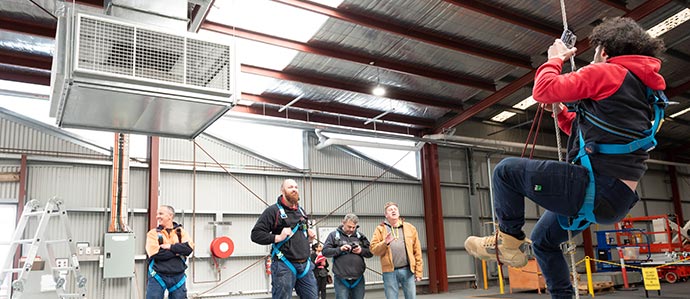
Work Safely at Heights
Work safely at heights prepares learners to assess risk and develop safe work methods for working at height.
HLTAID009 – Provide cardiopulmonary resuscitation

This unit introduces learners to the theory and the practical skills required to provide cardiopulmonary resuscitation (CPR) in line with the Australian Resuscitation Council (ARC) Guidelines. The training focuses on common situations in the construction industry, however, is suitable for anyone wanting to learn the basics of providing CPR. CPR will be practised on the floor using adult and child sized mannequins to simulate real-world scenarios.
The Australian Resuscitation Council recommends refreshing CPR skills (HLTAID009 – Provide cardiopulmonary resuscitation) annually.
This is a nationally accredited qualification that is recognised in all states and territories of Australia.
Students who complete this qualification will gain the skills and knowledge to:
Participants are required to:
There are no prerequisites for this course. No RPL can be applied to this course.
$100 – Full fee
$80 – Industry Association Member (NFIA, AMCA)
$0 – PTEU Member
Cancellation fees may apply, please see Learner Information page for terms and conditions.
A range of assessment methods will be used to assess that the learner can:
HLTAID009 – Provide cardiopulmonary resuscitation
Students who satisfactorily complete all course requirements will be eligible to receive a Statement of Attainment issued by CEPUTEC (RTO 4612), which is recognised nationally under the Australian Qualifications Framework.
Read this before you enrol.
Contact us for information about arranging training delivery at your workplace/worksite.

Work safely at heights prepares learners to assess risk and develop safe work methods for working at height.

Learn the practical skills and theory required to perform CPR in line with the Australian Resuscitation Council (ARC) guidelines.
If you study any Nationally Recognised Training in Australia, you are required to have a USI. Your USI links to an online account that contains all your training records and results (transcripts) that you have completed since 2015.
When applying for a job or enrolling in further study, you will often need to provide your training records and results (transcript). The benefit of the USI is the ability to provide learners with easy access to their training records at any time.
You can access your USI account online from your computer, tablet or smart phone.
If you do not already have a USI, go to www.usi.gov.au/students/create-your-usi/ on a computer or mobile device
Note: A USI must be supplied to CEPUTEC during enrolment so that a Nationally Recognised Qualification or Statement of Attainment can be issued to you.
For further information, please see the video under Learner Resources.